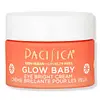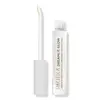What's inside
What's inside
 Key Ingredients
Key Ingredients

 Benefits
Benefits

 Concerns
Concerns

 Ingredients Side-by-side
Ingredients Side-by-side

Water
Skin ConditioningCaprylic/Capric Triglyceride
MaskingStearyl Alcohol
EmollientCarthamus Tinctorius Seed Oil
MaskingPolyglyceryl-2 Stearate
EmulsifyingButyrospermum Parkii Butter
Skin ConditioningTheobroma Cacao Seed Butter
EmollientJojoba Esters
EmollientSodium Ascorbyl Phosphate
AntioxidantPyrus Malus Fruit Extract
Skin ConditioningCaffeine
Skin ConditioningSodium Hyaluronate
HumectantHelianthus Annuus Seed Oil
EmollientCamellia Sinensis Leaf Extract
AntimicrobialArginine
MaskingCaprylhydroxamic Acid
Squalane
EmollientEthylhexyl Olivate
Skin ConditioningGlycerin
HumectantPropanediol
SolventSodium Gluconate
Skin ConditioningCetearyl Phosphate
Skin ConditioningCI 77891
Cosmetic ColorantCI 77491
Cosmetic ColorantCetyl Hydroxyethylcellulose
Emulsion StabilisingMica
Cosmetic ColorantCaprylyl Glycol
EmollientCitric Acid
BufferingWater, Caprylic/Capric Triglyceride, Stearyl Alcohol, Carthamus Tinctorius Seed Oil, Polyglyceryl-2 Stearate, Butyrospermum Parkii Butter, Theobroma Cacao Seed Butter, Jojoba Esters, Sodium Ascorbyl Phosphate, Pyrus Malus Fruit Extract, Caffeine, Sodium Hyaluronate, Helianthus Annuus Seed Oil, Camellia Sinensis Leaf Extract, Arginine, Caprylhydroxamic Acid, Squalane, Ethylhexyl Olivate, Glycerin, Propanediol, Sodium Gluconate, Cetearyl Phosphate, CI 77891, CI 77491, Cetyl Hydroxyethylcellulose, Mica, Caprylyl Glycol, Citric Acid
Water
Skin ConditioningGlycerin
HumectantButyrospermum Parkii Butter
Skin ConditioningGlyceryl Stearate Citrate
EmollientTitanium Dioxide
Cosmetic ColorantMica
Cosmetic ColorantHelianthus Annuus Seed Wax
Skin ConditioningSilica
AbrasivePolyglyceryl-3 Stearate
EmulsifyingSodium PCA
HumectantSimmondsia Chinensis Seed Oil
EmollientSr-Hydrozoan Polypeptide-1
HumectantAdansonia Digitata Seed Oil
EmollientOlea Europaea Oil Unsaponifiables
Skin ConditioningHydrogenated Lecithin
EmulsifyingShorea Robusta Resin
TonicRhus Verniciflua Peel Wax
Opuntia Ficus-Indica Seed Oil
EmollientTocopherol
AntioxidantSodium Hyaluronate
HumectantXanthan Gum
EmulsifyingGlyceryl Stearate
EmollientPolyglyceryl-2 Stearate
EmulsifyingStearyl Alcohol
EmollientPhenoxyethanol
PreservativeEthylhexylglycerin
Skin ConditioningTin Oxide
AbrasiveCitric Acid
BufferingWater, Glycerin, Butyrospermum Parkii Butter, Glyceryl Stearate Citrate, Titanium Dioxide, Mica, Helianthus Annuus Seed Wax, Silica, Polyglyceryl-3 Stearate, Sodium PCA, Simmondsia Chinensis Seed Oil, Sr-Hydrozoan Polypeptide-1, Adansonia Digitata Seed Oil, Olea Europaea Oil Unsaponifiables, Hydrogenated Lecithin, Shorea Robusta Resin, Rhus Verniciflua Peel Wax, Opuntia Ficus-Indica Seed Oil, Tocopherol, Sodium Hyaluronate, Xanthan Gum, Glyceryl Stearate, Polyglyceryl-2 Stearate, Stearyl Alcohol, Phenoxyethanol, Ethylhexylglycerin, Tin Oxide, Citric Acid
Ingredients Explained
These ingredients are found in both products.
Ingredients higher up in an ingredient list are typically present in a larger amount.
This ingredient is also known as shea butter. It is an effective skin hydrator and emollient.
Emollients help soothe and soften your skin. It does this by creating a protective film on your skin. This barrier helps trap moisture and keeps your skin hydrated. Emollients may be effective at treating dry or itchy skin.
Shea butter is rich in antioxidants. Antioxidants help fight free-radicals, or molecules that may harm the body. It is also full of fatty acids including stearic acid and linoleic acid. These acids help replenish the skin and keep skin moisturized.
While Shea Butter has an SPF rating of about 3-4, it is not a sunscreen replacement.
Shea butter may not be fungal acne safe. We recommend speaking with a professional if you have any concerns.
Learn more about Butyrospermum Parkii ButterCitric Acid is an alpha hydroxy acid (AHA) naturally found in citrus fruits like oranges, lemons, and limes.
Like other AHAs, citric acid can exfoliate skin by breaking down the bonds that hold dead skin cells together. This helps reveal smoother and brighter skin underneath.
However, this exfoliating effect only happens at high concentrations (20%) which can be hard to find in cosmetic products.
Due to this, citric acid is usually included in small amounts as a pH adjuster. This helps keep products slightly more acidic and compatible with skin's natural pH.
In skincare formulas, citric acid can:
While it can provide some skin benefits, research shows lactic acid and glycolic acid are generally more effective and less irritating exfoliants.
Most citric acid used in skincare today is made by fermenting sugars (usually from molasses). This synthetic version is identical to the natural citrus form but easier to stabilize and use in formulations.
Read more about some other popular AHA's here:
Learn more about Citric AcidGlycerin is already naturally found in your skin. It helps moisturize and protect your skin.
A study from 2016 found glycerin to be more effective as a humectant than AHAs and hyaluronic acid.
As a humectant, it helps the skin stay hydrated by pulling moisture to your skin. The low molecular weight of glycerin allows it to pull moisture into the deeper layers of your skin.
Hydrated skin improves your skin barrier; Your skin barrier helps protect against irritants and bacteria.
Glycerin has also been found to have antimicrobial and antiviral properties. Due to these properties, glycerin is often used in wound and burn treatments.
In cosmetics, glycerin is usually derived from plants such as soybean or palm. However, it can also be sourced from animals, such as tallow or animal fat.
This ingredient is organic, colorless, odorless, and non-toxic.
Glycerin is the name for this ingredient in American English. British English uses Glycerol/Glycerine.
Learn more about GlycerinMica is a naturally occurring mineral used to add shimmer and color in cosmetics. It can also help improve the texture of a product or give it an opaque, white/silver color.
Serecite is the name for very fine but ragged grains of mica.
This ingredient is often coated with metal oxides like titanium dioxide. Trace amounts of heavy metals may be found in mica, but these metals are not harmful in our personal products.
Mica has been used since prehistoric times throughout the world. Ancient Egyptian, Indian, Greek, Roman, Aztec, and Chinese civilizations have used mica.
Learn more about MicaPolyglyceryl-2 Stearate isn't fungal acne safe.
Sodium Hyaluronate is hyaluronic acid's salt form. It is commonly derived from the sodium salt of hyaluronic acid.
Like hyaluronic acid, it is great at holding water and acts as a humectant. This makes it a great skin hydrating ingredient.
Sodium Hyaluronate is naturally occurring in our bodies and is mostly found in eye fluid and joints.
These are some other common types of Hyaluronic Acid:
Learn more about Sodium HyaluronateStearyl Alcohol is a type of fatty alcohol from stearic acid. It is a white, waxy compound used to emulsify ingredients.
Fatty Alcohols are most often used as an emollient or to thicken a product. Emollients help soothe and hydrate the skin by trapping moisture.
They are usually derived from natural fats and oils and therefore do not have the same drying or irritating effect as solvent alcohols. FDA allows products labeled "alcohol-free" to have fatty alcohols.
Learn more about Stearyl AlcoholWater. It's the most common cosmetic ingredient of all. You'll usually see it at the top of ingredient lists, meaning that it makes up the largest part of the product.
So why is it so popular? Water most often acts as a solvent - this means that it helps dissolve other ingredients into the formulation.
You'll also recognize water as that liquid we all need to stay alive. If you see this, drink a glass of water. Stay hydrated!
Learn more about Water